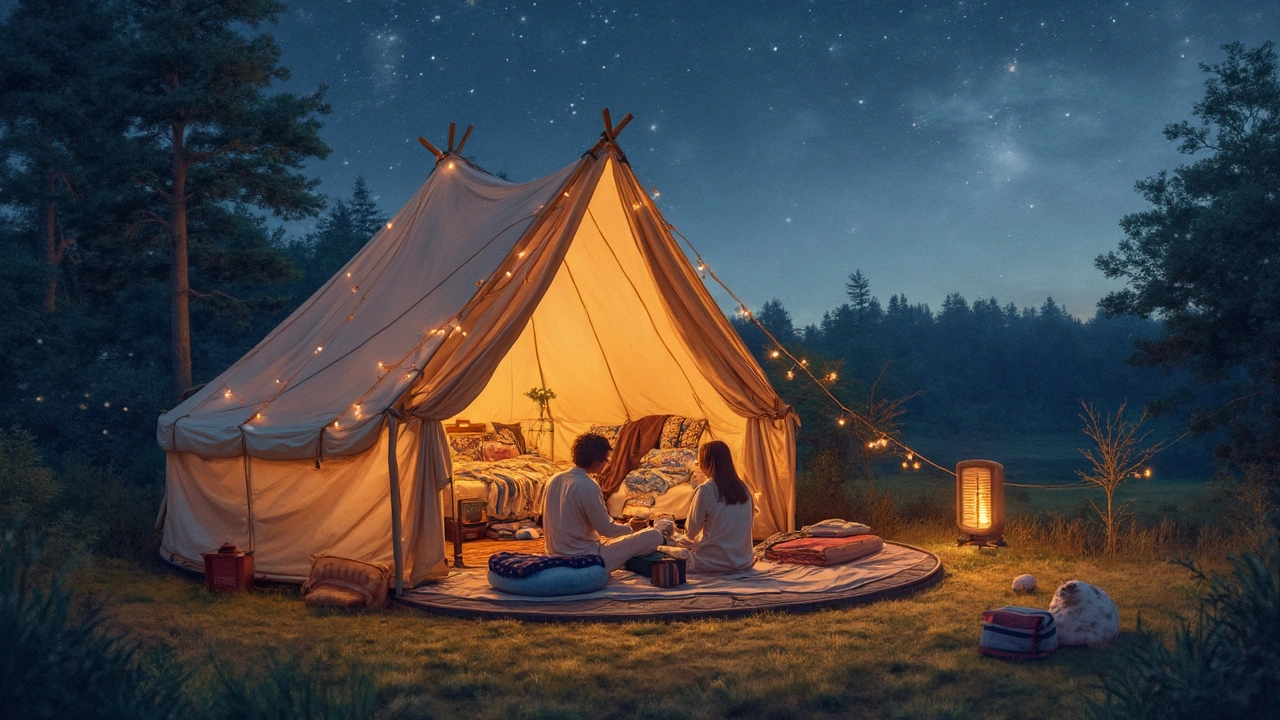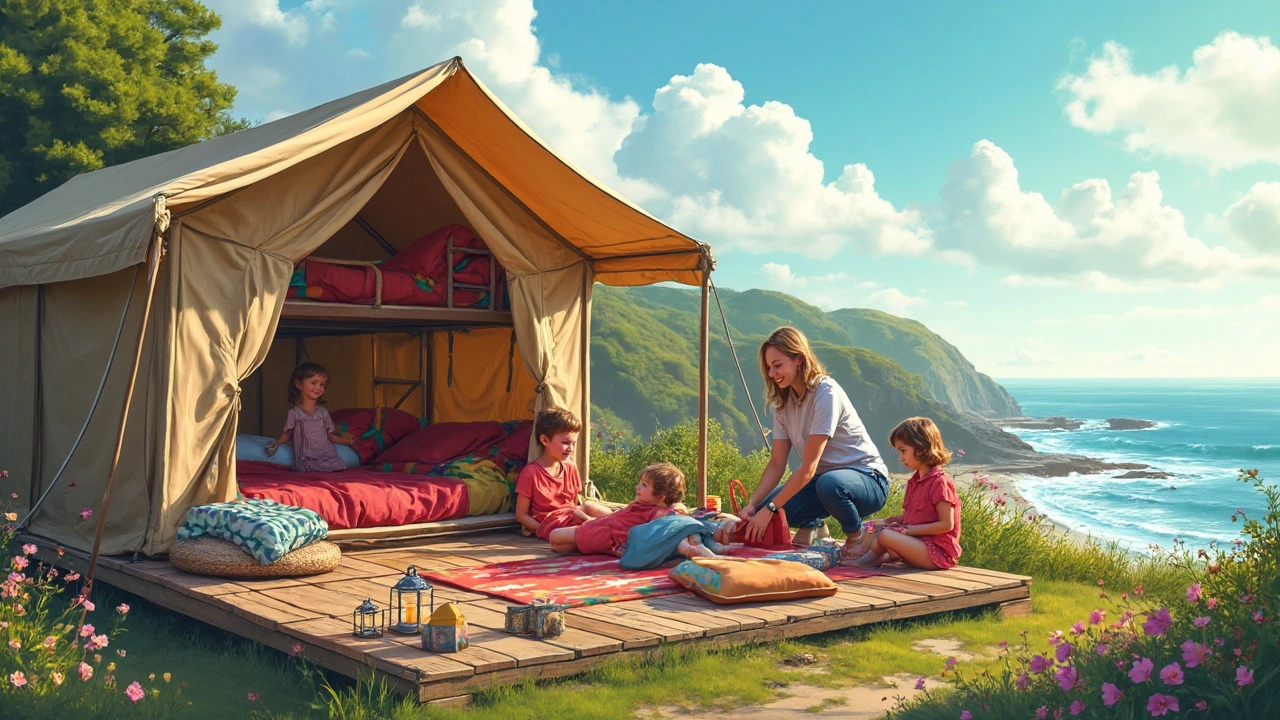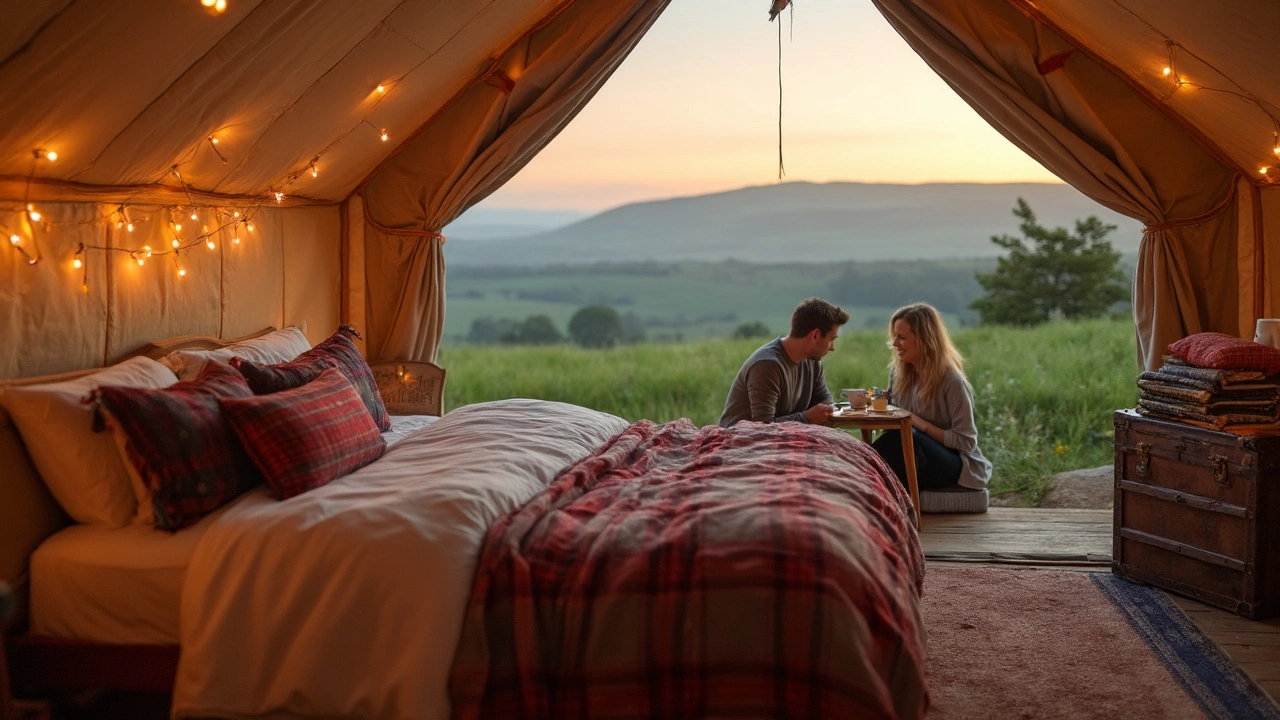Best Glamping Sleep Setups: Beds, Tents, and Sleep Gear for Luxury Camping
30 Jun, 2025Imagine stepping into the forest, but instead of struggling with a thin roll-up mat and a cheap sleeping bag, you sink into a plush bed piled high with real bedding inside a tent big enough to stand up in. Welcome to glamping—where camping meets luxury and sleep finally gets the respect it deserves. Some folks still think glamping means just a fancier sleeping bag, but trust me, you’re in for a whole different world. So what exactly do you sleep in when you go glamping? Let’s break down the real options, the gear you’ll find, and how the top setups put good old-fashioned camping to shame.
Glamping Tents: Far from Your Ordinary Shelter
Forget images of cramped nylon cocoons that barely fit you and your duffel. The moment you walk into a glamping tent, the difference hits you in the face—literally. These tents are tall, roomy, and feel more like boutique hotel suites with a lot of air. Bell tents, safari tents, yurts, even geodesic domes—each takes camping up several notches. Unlike regular tents, these are built for comfort, with enough space to lay out a proper full-size or queen bed and move around without ducking every two feet. Standard bell tents often start at 13 feet in diameter, which means you can splurge on real furniture (think nightstands, lamps, and even rugs) for that homey vibe.
Most glamping sites don’t skimp on insulation, sturdy canvas exteriors, and waterproof bases, which means sleeping through a downpour won’t turn into a soggy nightmare. Airflow doesn’t get forgotten either—most tents boast mesh windows and doors to keep bugs out and breezes in. Some setups even offer wood stoves for those chilly nights. Yurts—used for centuries by Mongolian nomads—are famous for their thick felt walls and solid wooden frames, making them ideal for four-season sleeping. If you’re clinging to that ‘outdoors but inside’ mood, try a bubble tent. These clear, pressurized domes give you panoramic views of starry skies, while still letting you turn up the heat (literally—some even come with portable AC units). The fact that these shelters can stand up to all weather while keeping your luxury bedding dry is frankly impressive. I once glamped during a thunderstorm and slept through the night comfortable and dry, waking up to the sound of rain on strong canvas, not soggy ground sheets.
It’s not just tents. Treehouses, pods, and even vintage airstreams fall under the glamping umbrella, each with their unique sleep setups. You might end up in a fully waterproof dome with blackout curtains and cozy throws or a Nordic hut with underfloor heating and double-glazed windows. All these options are built around one purpose: giving you the best possible night’s sleep, no matter what’s happening outside. A recent UK survey found the most popular glamping accommodation is the bell tent, followed closely by safari tents and yurts.
| Accommodation Type | Avg. Size (sq ft) | Avg. Sleeps | Insulation |
|---|---|---|---|
| Bell Tent | 130-300 | 2–6 | Canvas, cotton, with wood stove optional |
| Safari Tent | 150–400 | 2–6 | Multi-layered canvas, insulated base |
| Yurt | 200–500 | 2–8 | Felt, insulated liner, wooden frame |
| Bubble Dome | 150–300 | 2–4 | Double-layer clear plastic, optional climate control |

Luxury Beds and Sleep Gear: Ditch the Sleeping Bag
Let’s not sugarcoat sleeping in a glamping tent—at most glamping spots, you sleep in a real bed. You’ll find beds with proper frames, thick mattresses (some even memory foam or natural latex), box springs, and real sheets. Upgrading from a saggy roll mat to a queen-sized four-poster makes a serious difference in how you wake up—no more feeling like you lost a fight with a tree root. In the best sites, you’ll have throw pillows, down duvets, and even an electric blanket or heating pad for colder months. If you’re at a spot that calls itself glamping but offers just upgraded camping pads, you’re missing out on the full experience.
You’ll sometimes run into creative sleep setups as well. Think hanging beds, canopy beds, or Japanese-style futons set atop thick rugs or heated floors. Want to go for extra coziness? Many sites provide thick fleece or wool blankets—perfect because it can get surprisingly cold at night, even in summer. Some go the extra mile with weighted quilts, scented lavender pillows, and even warming water bottles for your feet. Don’t forget blackout curtains for a proper night’s sleep—these are absolutely a thing in glamping tents.
What about personal sleep gear? If you decide to bring your own touch of comfort, memory foam mattress toppers are a winner—add those on top of the provided mattress, and you’re golden. Silk sleeping masks and noise-canceling earbuds make a difference if you’re a light sleeper or your site is close to a festival. A travel-size pillow with a familiar scent from home (I spray mine with a bit of fabric freshener Whiskers likes—yes, I let my cat have an opinion) helps me sleep just about anywhere. For folks with allergies, play it safe with a hypoallergenic pillow cover. And swap the standard sleeping bag for large, full-size sheets if your site allows. Few things beat waking up in crisp, hotel-style bedding surrounded by the sounds of nature.
To keep your sleep gear fresh and organized, soft-sided storage chests or collapsible bins are a must. Nobody wants their pj’s or slippers lost at the bottom of a duffel when you’re getting ready for bed. And if you’re really going all out, portable diffuser with essential oils or a battery-powered white noise machine can turn even the most basic glamping sleep into spa-like rest. It’s wild how far sleeping at camp has come in just a decade—according to market data, glamping bookings that include ‘luxury beds’ have tripled since 2021. People want comfort, and let’s face it: why shouldn’t you have your best sleep ever in the wild?

Tips and Real-Life Tricks for Sleeping Well While Glamping
Let’s talk practical hacks: real sleep starts before you ever climb into that bed. First, check if your glamping site offers adjustable beds or mattress options and book early—the best sleep setups go fast. If you run cold, ask ahead if they provide extra blankets or space heaters. For summer glamping, portable fans or tents with built-in mesh panels make all the difference at night. Watch for locations boasting blackout curtains if you’re a light sleeper or plan to glamp in areas with early sunrises. Noise varies a lot too; from remote mountain silence to festival-adjacent buzz or woodland critters. Years of camping with Whiskers taught me: never underestimate the value of a battery-powered noise machine or at least earplugs.
Keep your things tidy. Use your own laundry bag for dirty clothes and a compact shoe rack to keep muddy boots from sharing tent space with your bed (honestly, game changer). If you’re planning to charge electronics overnight, check if your site has outlets or bring a power bank—waking up to a dead phone because you thought nature meant off-the-grid can be rough. Got allergies or asthma? Call ahead and ask about any recent deep cleaning and if natural dust sources are present. Hotels have standardized checklists, but each glamping spot is unique—don’t gamble when it comes to breathing clean air.
Hydration matters, especially in canvas tents where airflow can mean waking up parched. Keep a reusable water bottle within reach. Light-sleepers: toss a soft scarf or bandana over your head to soften stray noises and moonbeams at night. A personal favorite: bring a soft, portable reading lamp—not all places have bedside lamps, and fumbling for your phone at 2 AM isn’t anyone’s idea of a good time. If you’re glamping with kids or pets, bring a familiar blanket or plushie to help everyone settle in. And if you ever snag a spot that lets you bring your cat (lucky, right?), a portable litter box stashed in the tent’s vestibule keeps sleep and sanity intact for felines and humans alike.
Finally, don’t forget the fun stuff: string lights, battery lanterns, and scented candles (real or flameless) set a cozy mood that helps you unwind before bed. Simple routines like laying out your pajamas ahead of time or spritzing a lavender spray on your pillow work wonders for better sleep—even outdoors. Glamping’s all about comfort, so embrace it. These sleep setups aren’t just practical—they’re indulgent. And really, isn’t that the whole point?

 by
by